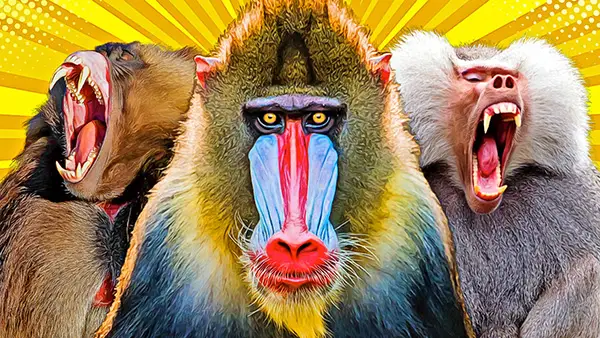All 9 Baboon & Mandrill Species (World’s Largest Monkeys)
There are well over 100 species of Old World monkeys, the majority of which are relatively small. The adorable talapoins of Africa are the smallest, weighing no more than around 4 lb (1.9 kg / 4.2 lb). Japanese macaques are significantly larger at 25 lb (11.3 kg) but are still dwarfed by China’s golden snub-nosed monkeys who weigh north of 40 lb (19.8 kg / 43.7 lb). This article will focus exclusively on three genera containing the largest and arguably some of the most fascinating monkeys. Although the smallest baboons are comparable in size to some Asian species, the largest members of this genus are surpassed only by mandrills and hence is where we’ll start.
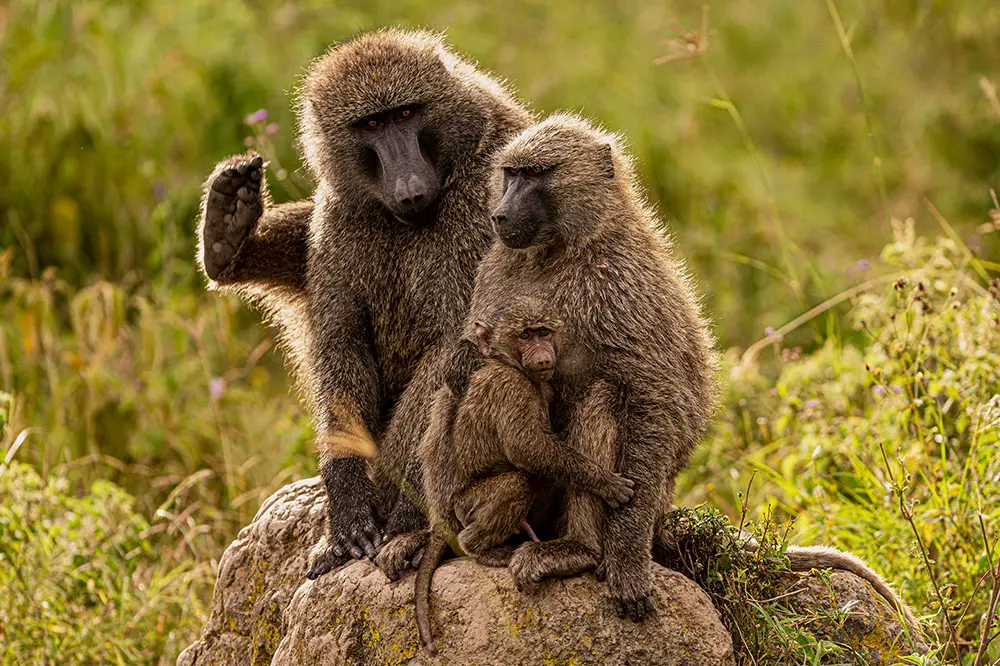

Left: Anubis baboon family / Shutterstock & Right: Large male mandrill / Shutterstock
Contents
- Baboon Physical Characteristics & Distribution
- Olive/Anubis baboon | Papio anubis
- Chacma baboon | Papio ursinus
- Yellow baboon | Papio cynocephalus
- Guinea baboon | Papio papio
- Hamadryas baboon | Papio hamadryas
- Baboon Ecology & Diet
- Baboon Social Structure
- OMUs | One-male Units
- MMUs | Multi-male Multi-female Units
- Baboon Communication & Reproduction
- Gelada Baboon | Theropithecus gelada
- Mandrill and Drill | Mandrillus sphinx/leucophaeus
Baboon Physical Characteristics & Distribution
There are several physical characteristics that all 6 species of baboons share. Perhaps their most distinguishing feature is a long pointed muzzle, which is often described as dog-like and is in sharp contrast to the flat facial profile of many other primates. As quadrupeds, baboons bear weight on all four limbs and have a particularly interesting tail, which is not prehensile and is erect at the base but then droops towards the middle and end. Like all Old World monkeys, baboons have sitting pads known as ischial callosities, which amount to thick layers of tissue on their rumps allowing them to sit for long periods of time and rest in an upright position. The skin surrounding these callosities is hairless and varies in colour and size between species. Baboons are also highly sexually dimorphic; males are much larger with particularly long canines and in some species display various differences in pelage. One of their most interesting physical characteristics is the appearance of their young; in many species, infants are born with a black natal coat, which lightens within 6 months as well as exhibiting light skin, which darkens with age.


Left: Male chacma baboon side profile / Shutterstock & Right: The ischial callosities of the hamadryas baboon / Shutterstock
Olive/Anubis baboon
The Olive or Anubis baboon is one of the most well-known species and, as its name suggests, sports an olive-coloured coat, which features rings of black and yellowish-brown on each individual hair giving them an intricate, multi-coloured appearance. Olive baboons are one of the larger members of this genus with females weighing up to 30 lb (14 kg / 30.9 lb) and males topping out around 55 lb (25 kg) although this varies by location and access to food. The males have a lion-like mane which runs across the shoulders and along the back. Positioned mostly in Sub-Saharan Africa, this species has a wide distribution, spanning almost the entire width of the continent.
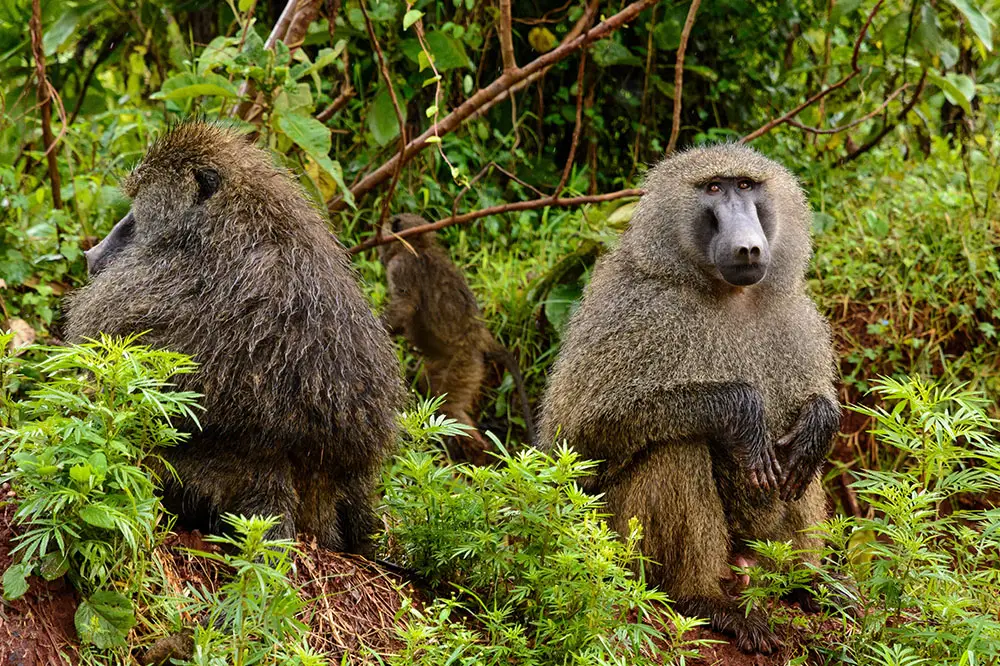
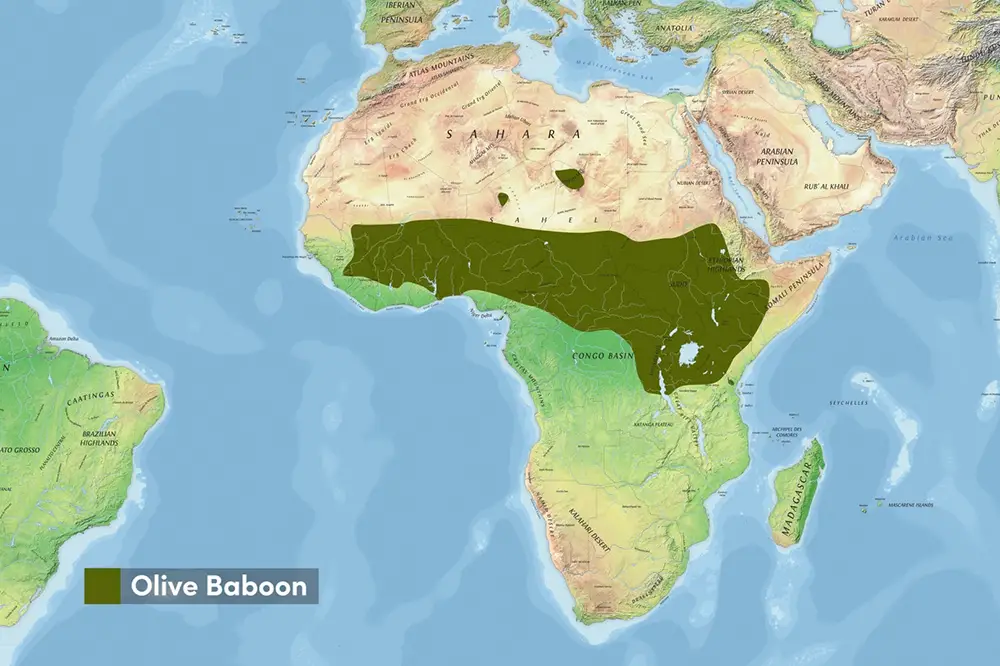
Left: Olive baboon, Ngorongoro Conservation Area, Tanzania / Shutterstock & Right: Anubis baboon distribution
Chacma baboon
The largest of these monkeys is the chacma baboon, males can weigh just under 70 lbs (31 kg / 68 lb) and some sources list them even heavier. These baboons generally have a darker pelage with a single yellow-brown band on each individual hair, however, their colouration varies geographically with some members of this species being referred to as grey-footed baboons, which are smaller with lighter fur. In contrast to the olive baboon, the skin of chacmas is described as purple-black and males do not have a mane. This species is found in Southern Africa, extending no further than Southern Angola and parts of Zambia.

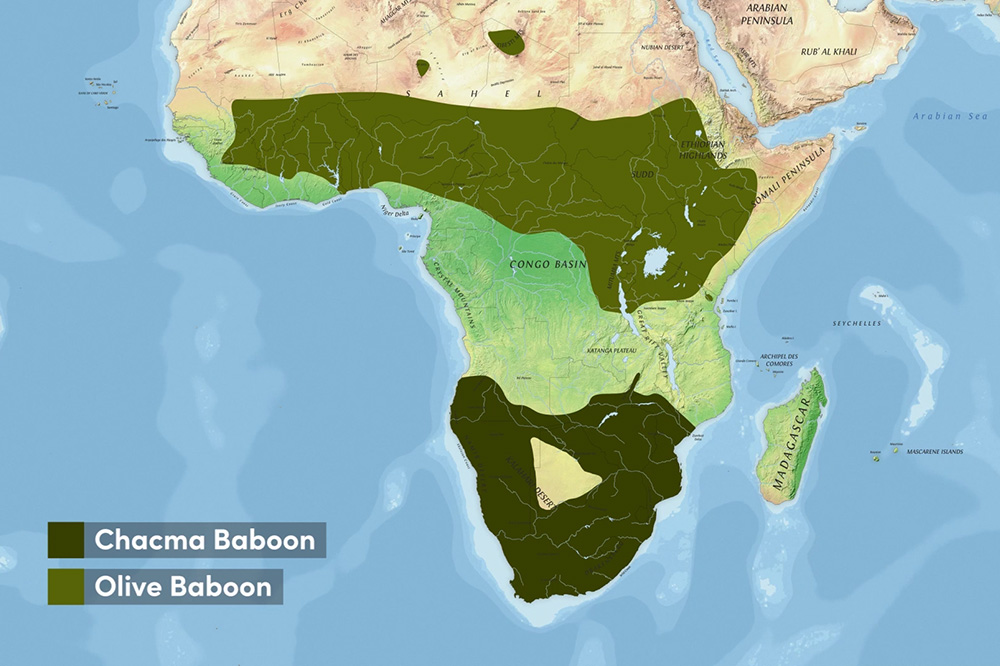
Left: Chacma baboon side profile / Shutterstock & Right: Chacma baboon distribution
Yellow baboon
The appearance of the yellow baboon is exactly as you might expect; hairs are a wonderful yellow-brown colour with black tips and, like the chacma baboon, males do not generally exhibit a mane, although this varies by geography with some males showing noticeably longer hair than others. This species is one of the smaller baboons with females weighing no more than 26.5 lbs (12 kg) and males no more than 50 (23 kg / 50.7 lbs). Geographically they are positioned between the olive and chacma populations with hybridization occurring in areas of overlap with the olive baboon. As of 2013 this distribution is now segmented with the Kinda baboon, found to the west, now considered a separate species.
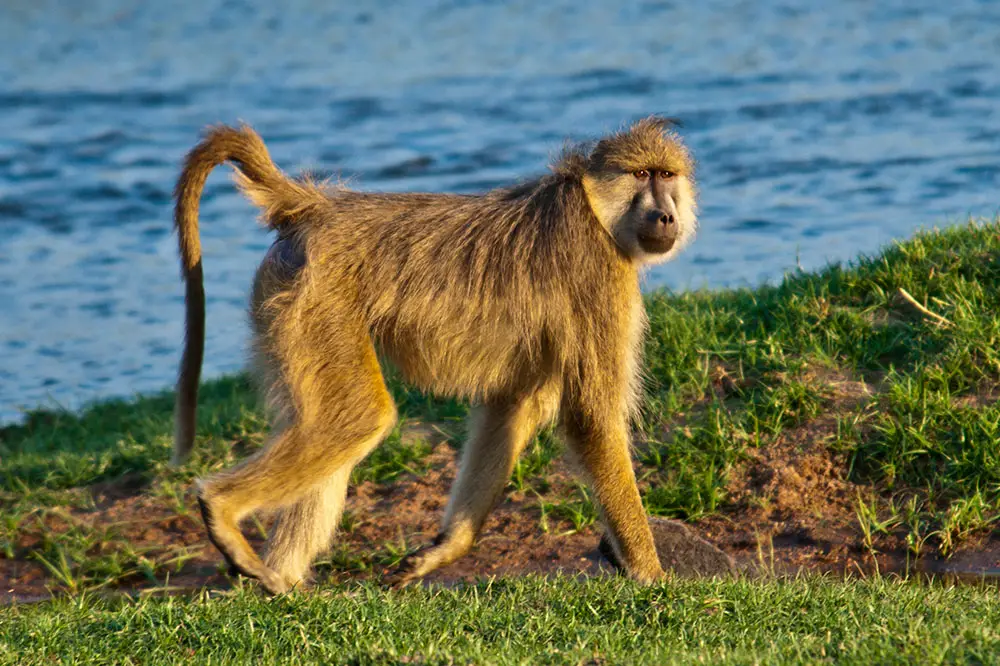

Left: Yellow Baboon walking along Lake Ruaha, Tanzania / Shutterstock & Right: Yellow & Kinda baboon distribution
Guinea baboon
The Guinea baboon is roughly the same size as an olive baboon (29 – 57 lb / 13 – 26 kg) and is the last species that is not drastically different from those previously mentioned, sporting a reddish-brown coat, although this can also vary considerably throughout their range. The mane of males is present in Guinea baboons and interestingly, prior to pregnancy, females have dark skin on their rump, which can turn permanently pink once pregnant. This species is located on the far western tip of Africa and, unfortunately, is the only species with a conservation status of Near Threatened.


Left: Guinea baboons with infant / Shutterstock & Right: Guinea baboon distribution
Hamadryas baboon
Switching gears, the Hamadryas is the last baboon species to discuss in this genus and is by far the most unique visually. They are the smallest of the baboons with females weighing no more than 20 lbs (9.4 kg / 20.7 lbs) and males just under 50 (21.5 kg / 47.4 lbs). In addition to being sexually dimorphic by size, they are also sexually dichromatic with males displaying a spectacular greyish-white pelage with a large mane whereas the coat of females is a darker brown. Their skin is also drastically different to other species being light rather than dark and the skin around the ischial callosities is noticeably larger and more pronounced in a deep pink colour. As we’ll discover later on, this species is unique in almost every way. They are found on the far eastern tip of Africa and across the Red Sea on the Arabian Peninsula and also hybridise with olive baboons where their ranges overlap in Ethiopia.
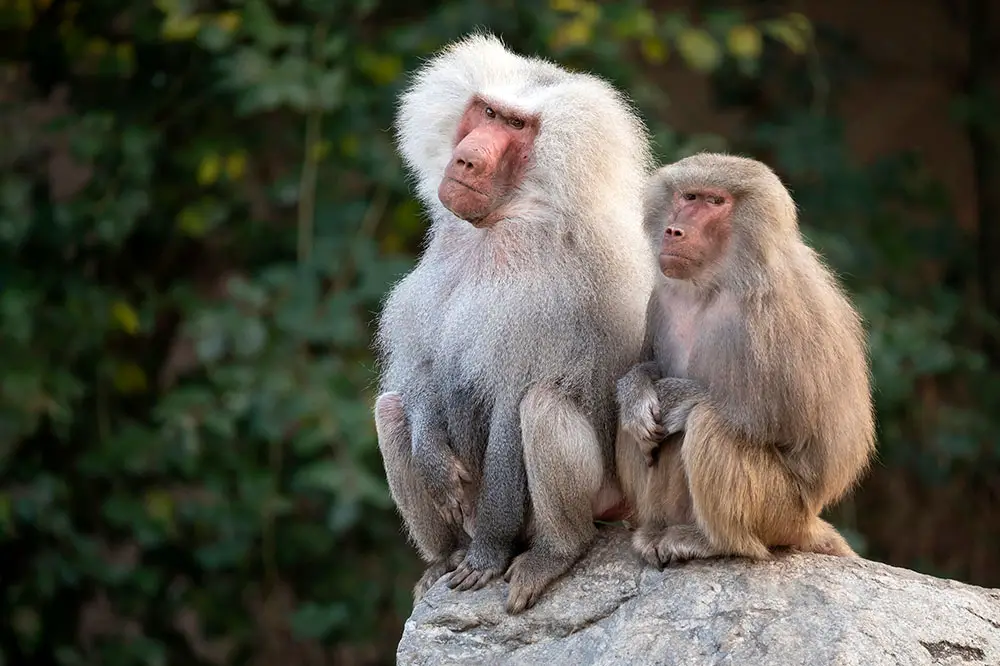
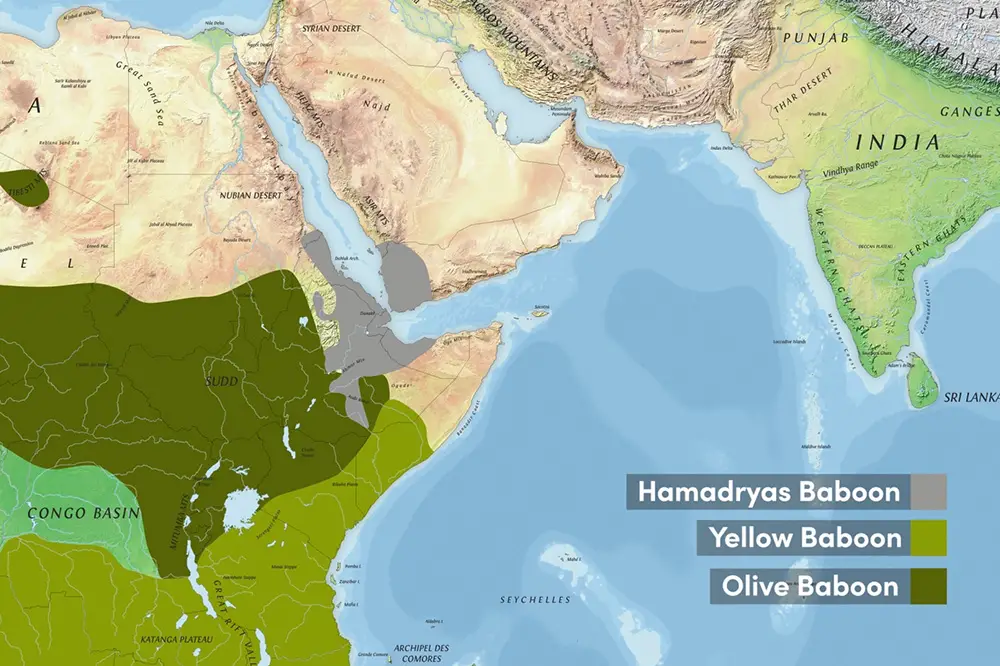
Left: Hamadryas male and female / Shutterstock & Right: Hamadryas baboon distribution
Baboon Ecology & Diet
Baboons are generally thought of as savanna monkeys, roaming the tropical grasslands of Africa alongside the various other spectacular animals of the continent. However, the ecosystems they inhabit can be much more diverse, ranging from other types of grassland and wooded areas to full-on tropical forest. The Hamadryas baboon is also found in arid areas as well as the Ethiopian highlands.
All species of baboon are terrestrial, spending much of the day foraging on the ground although they are no stranger to the arboreal environment. Trees provide a safe haven for monkeys when it’s time to sleep, offering protection from predators such as large cats and snakes. Hamadryas and some olive baboons will also sleep on cliff faces.
Baboons are considered some of the hardiest monkeys, possessing the ability to survive off a low-quality diet made up of grasses and other vegetation with low nutritional value. In addition to these low-quality sources, when food is plentiful, baboons will, amongst other things, eat fruits, flowers and leaves as well as a wide variety of animals from termites and bird eggs all the way up to small antelopes and even other primates such as vervet monkeys.
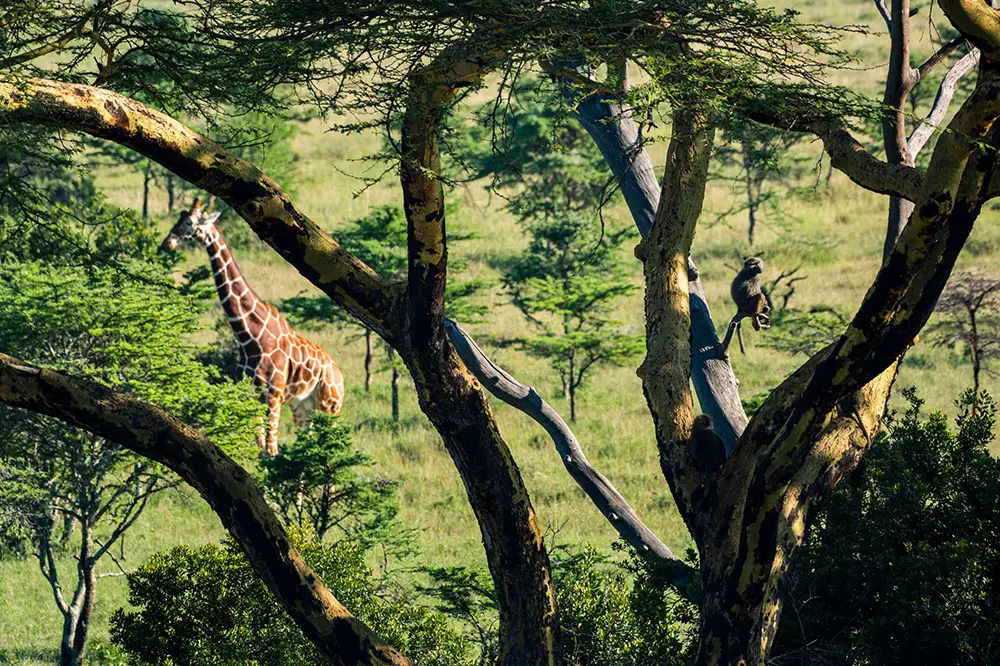

Left: Olive baboon in the trees in Kenya / Shutterstock & Right: Infant baboon feasting / Shutterstock
Baboon Social Structure
One of the most interesting aspects of baboon life is their group structure and associated behaviours. Baboons use two contrasting social strategies; One Male Units known as OMUs and Multi-male Multi-female units known as MMUs.

One-male Units / OMUs
One Male Units are used predominantly by Hamadryas and Guinea baboons although this group structure is also seen in mountain populations of chacmas and infrequently in other species. These units are made up of a single adult male and multiple adult females with both female and male juveniles. Hamadryas OMUs average 7 individuals but can range from 2 to 23 members. Because there is only one adult male, he is able to mate with the adult females of the group with little to no competition. Movement of the OMU is controlled by the male and in Hamadryas baboons, herding is done aggressively to prevent females from socialising with other males.
These baboons can still be part of a large troop, however. This kind of social structure is referred to as a fusion-fission society. Fission refers to the larger group splitting up into smaller units, for example, when foraging for food, whereas fusion refers to these small units banding together for protection or, for example, if they need access to a watering hole.
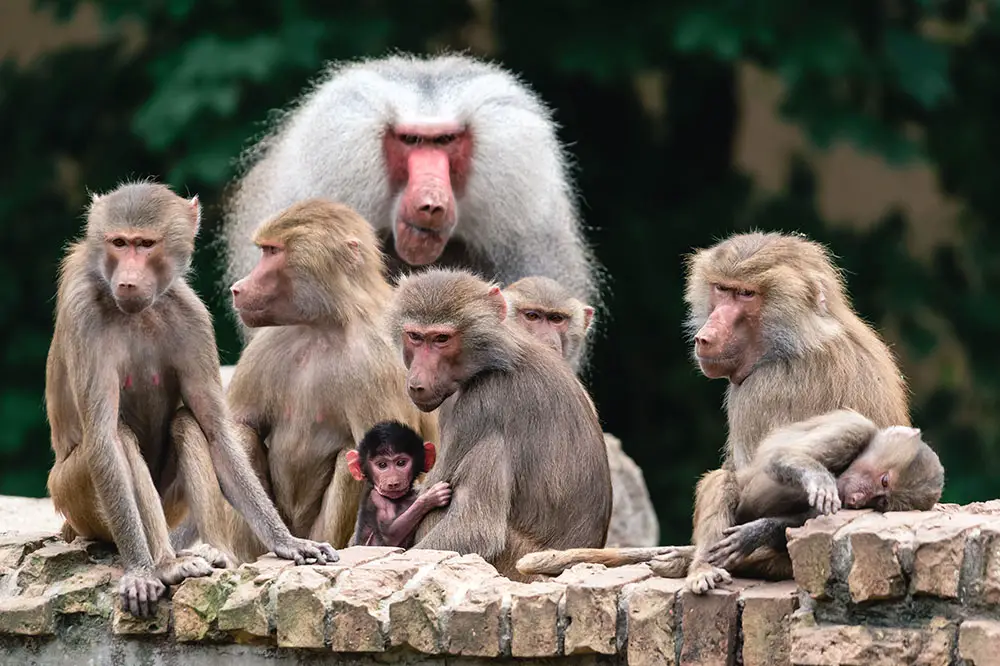
Multi-male Multi-female Units / MMUs
In contrast, the Multi-male multi-female unit is most characteristically used by olive or Anubis baboons. Mating in these societies is polygynandrous, which sees both males and females copulating with multiple partners. In this type of society, there is frequent competition between males and a subsequent dominance hierarchy, which can sometimes be circumvented by an alliance between males to secure better mating access. In MMUs, males leave the troop upon puberty and so the social core of the group is described as matrilineal, being made up of closely related females with a more stable dominance hierarchy.

Baboon Communication & Reproduction
Another essential part of any monkey society is communication. Vocalisations are often described as barks and are used for a wide range of purposes from making threats to warning others of predators. Baboons also use physical signals to communicate such as displaying their hindquarters, which is used as a submissive signal or staring, which is aggressive. Grooming also plays an important role and is used to strengthen bonds between individuals.
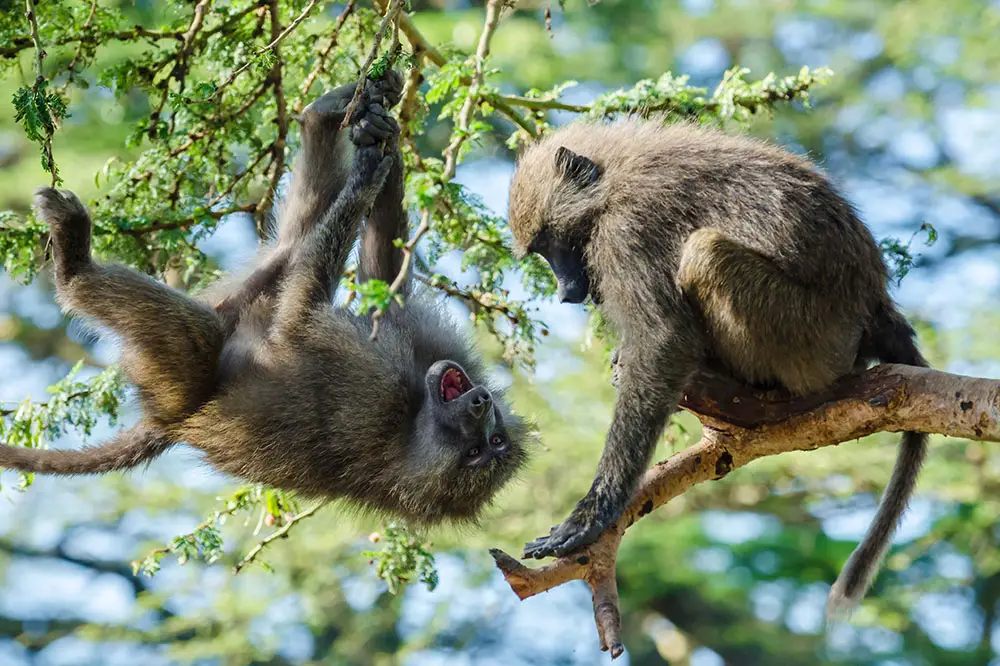
Finally, it would be a travesty to move on to the next genus without quickly discussing babies! Mating is done throughout the year and, once successful, gestation for baboons lasts around 6 months. Newborns cling to their mother’s chest where they suckle milk while she forages and moves around and then progress to her back as they become older. By three to four months, infants will begin to eat solid food but won’t be fully weaned until just over 1 year of age. Sexual maturity is reached in anywhere from 3 to 6 years depending on sex and species, with females reaching maturity before males. Lifespan is around 25 to 30 years in the wild and once sexually active, the interbirth interval of females ranges from 18 to 27 months.
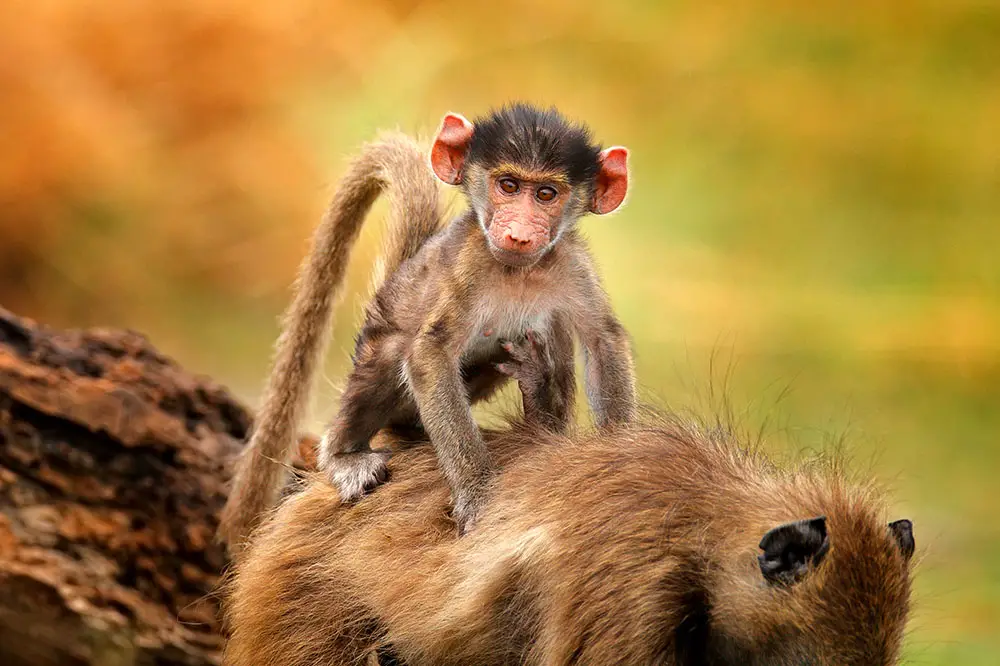

Left: Chacma baboon mother and infant in Moremi, Okavango Delta, Botswana / Shutterstock & Right: Hamadryas baboon babies / Shutterstock
Gelada Baboon
There is one animal that is perhaps more spectacular than the species covered so far and is often referred to as a baboon but is from a separate genus. The gelada is found only in the Ethiopian highlands at elevations between 5000 ft (1500 m / 4921.3 ft) and 15,000 ft (4500 m / 14763.8 ft). Visually, they are quite similar to the members of the Papio genus but have noticeably shorter muzzles with nostrils much closer to the eyes. The mane of the male is particularly magnificent and by far the largest of any species in this article, however, this does give them a deceptively large appearance. Males weigh no more than 46 lbs (21 kg), which is a fraction smaller than Hamadryas males, whereas females are a little larger than their Arabian counterparts at 30.8 lbs (14 kg). These animals are also referred to as the bleeding heart baboon, referencing the hourglass-shaped bare patch of bright pink skin on their chests. In females, the patch becomes more pronounced when she is ready to mate.

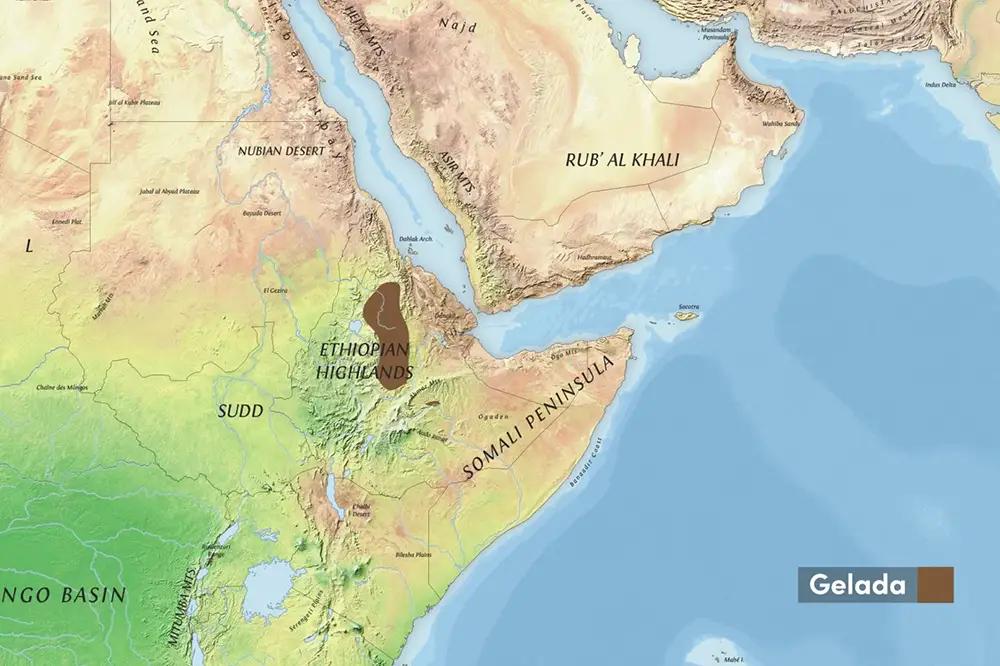
Left: Female bleeding heart baboon / Shutterstock & Right: Gelada baboon distribution
With the vast majority of their feeding done on the ground and night time spent on the side of cliffs, geladas are one of, if not the most terrestrial non-human primates. In contrast to their cousins who eat meat, these monkeys are herbivorous and spend up to 10 hours per day grazing on grass, which can make up to 90% of their diet depending on the season. Their group structure is most similar to that of the Hamadryas baboon, being found in One Male Groups, although Geladas are more placid and not territorial. Several of these smaller units joined together form a band, which can number well over 100 and look quite incredible roaming the highlands of East Africa.


Left: Male gelada with large mane / Shutterstock & Right: Troop of gelada baboons on a cliff face / Shutterstock
Mandrill and Drill
All of the species featured so far are large when it comes to monkeys but there is one final genus to discuss that contains the two largest monkeys on the planet.
The drill is certainly lesser known than its colourful cousin, which, at least in my opinion, makes it even more fascinating. In terms of size, males usually weigh just north of 70 lb (32.3 kg / 71.2 lb) which is a fraction larger than a chacma baboon. The females are much smaller weighing only 25 lb (11.5 kg) on average. Both males and females are similar in colour, exhibiting a dark brown pelage with white highlights around the face and belly and a bright pink lower lip. Their wide faces are shiny black in colour with prominent ridges that run along the snout, making them quite distinct from both baboons and the mandrill, whose ridges are smaller but more numerous and brightly coloured. The rump is quite colourful in this species, especially when the male becomes excited and the genital area is bright red and blue.


Left: Male drill with pink lip / Shutterstock & Right: Female drill with infant / Shutterstock
If you thought this colouration was impressive, I’d like to introduce to you the mandrill! This species is the largest monkey on the planet and one of the most visually impressive. Large males usually weigh up to 82 lbs (37 kg), although they have been recorded at a staggering 120 lbs (54 kg). They display the most extreme form of sexual dimorphism of all species covered with females weighing around a third of the weight of an average male at 25 lb (11.5 kg). The pelage of mandrills is also dark brown but with beautiful orange highlights, which are particularly vibrant in males who also exhibit a bright blue and red snout and long canine teeth. This facial colouration is much more subtle in females and in juvenile males. The anogenital area of the mandrill is also vibrantly coloured with arguably the most colourful rump in the animal kingdom.

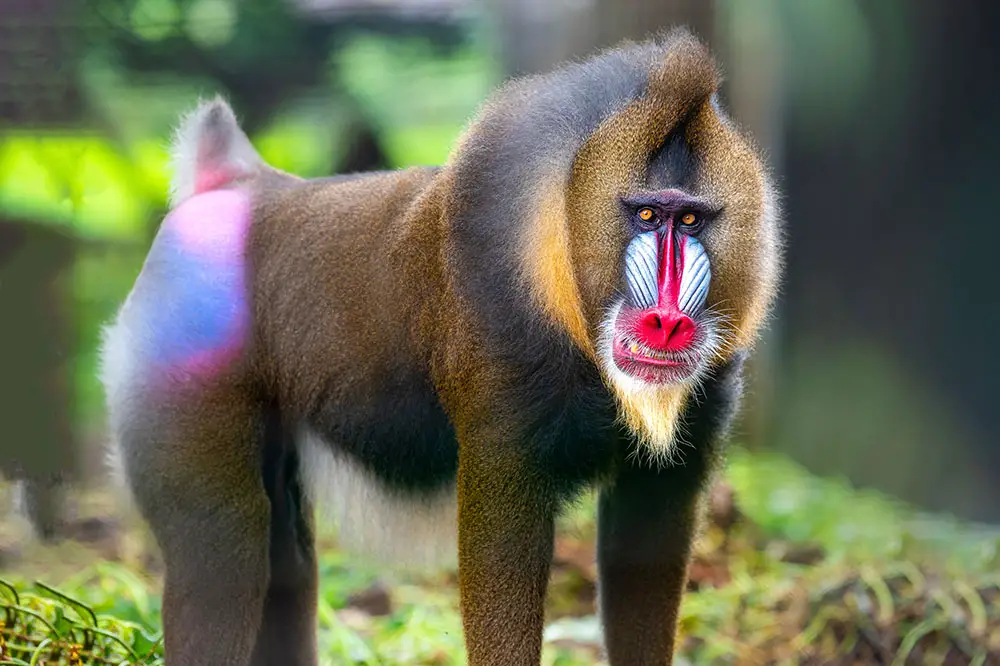
Left: Mandrill family / Shutterstock & Right: Colourful male mandrill / Shutterstock
The members of this genus are found only in West and Central Africa. The drill is found in two separate locations; one subspecies on mainland West Africa and another on Bioko Island. The Mandrill is found to the southeast of this range and is separated from the drill by the Sanaga River.
These monkeys are found in rainforest habitats where they spend much of their time harvesting fruit and other vegetation as well as snacking on invertebrates, eggs and even small mammals. They are mostly terrestrial but, like baboons, will retreat into trees at night to avoid predators such as leopards.

Both of these species live in medium-sized multi-male multi-female groups that number up to 20 for drills and 40 for mandrills all of which are led by a dominant male. In typical fusion-fission fashion, these groups will link up to form a troop, sometimes numbering 600-800 members for mandrills.
Although there is much less known about the reproductive and parental tendencies of this genus when compared to baboons, young mandrills are some of the most heart-warming primate infants and like baboons are born after a gestation period of 6 months.
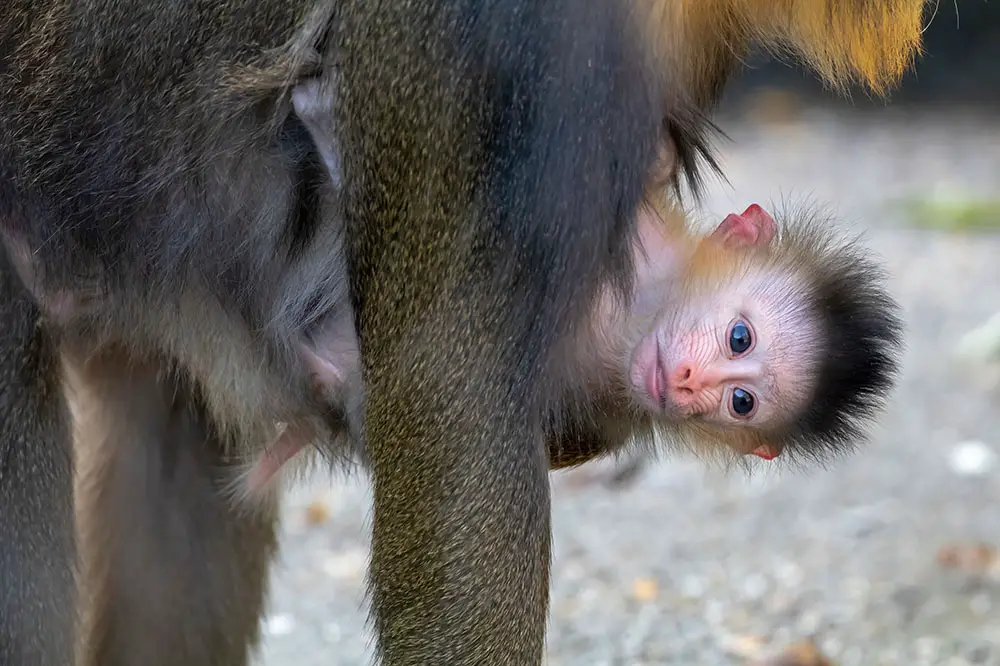

Left: Adorable mandrill baby / Shutterstock & Right: Drill infant in mother’s arms / Shutterstock

